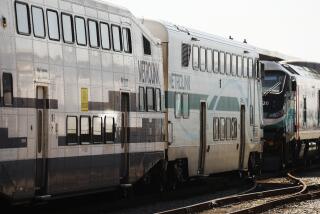Quake Doubles Use of Trains, Survey Finds : Transit: Many of the new riders cite damaged freeways as their reason for taking Metrolink. But white male professionals are still most frequent users.
Southern California’s commuter trains carry twice as many passengers now as before the Northridge earthquake, and the average rider is a well-heeled white male professional from the suburbs, according to results of a survey released Friday.
The number of women and minority group riders increased only slightly, if at all, in the past year, the survey found.
Nearly half the Metrolink system’s 15,500 daily riders began taking the periwinkle and white trains after the January quake. Many of those new customers--one-sixth of the current passengers--identified quake damage to the freeways as the reason they ride Metrolink.
Metrolink passengers overall--the majority of whom receive subsidies from their employers to take the train--continue to report high satisfaction with the 2-year-old train service, although some complain of high fares, delays and poor connections at their destinations.
The survey results, based on a Metrolink poll of 4,527 riders in June, show little change in the typical passenger profile since a similar study last year.
Despite some official attempts to diversify ridership, the trains still attract affluent white-collar workers--mostly male executives and managers--from households with an average annual income of $64,450. More than half (55%) receive subsidies from their employers to ride the trains. The subsidies average $58 a month.
The socioeconomic status of Metrolink customers continues to stand in stark contrast to that of the region’s bus users, who are overwhelmingly members of ethnic minority groups with household incomes of less than $30,000 a year.
That disparity was recently brought into the debate over the decision to raise bus fares for the first time in six years. Metrolink officials slashed fares for several months as an earthquake-relief measure.
The surveyed riders gave Metrolink high marks for service, personal safety and professional courtesy from staff. They said they are under less stress because they no longer have to drive to work. Three out of five passengers surveyed had commuted alone by automobile.
Still, 75% of riders--even those who live within five miles of their stations--drive alone to the train station, which means they “cold start” their cars each workday morning. Cold starts are the single biggest contributor to air pollution.
The survey, which Metrolink officials said has a margin of error of less than 2 percentage points, found that:
* Nearly half of all passengers began using the system after the January earthquake. About 48% of these new customers identified the temblor as their reason for turning to the trains. They account for one-sixth of the current ridership. On the Santa Clarita line, three out of four passengers traced their ridership to the quake.
* 52% of riders are men--the same proportion as last year--while 48% of passengers are women, up from 45%. (In last year’s survey, 3% of respondents did not identify themselves as male or female.)
* As was the case last year, whites make up two-thirds of those who ride the trains. The proportion is even higher along some routes, such as the Ventura line and the recently opened Orange County line (80% for both) and the Santa Clarita line (74%).
* The percentage of African Americans using Metrolink rose to 9.4% this year from 7% last year. Latinos registered a tiny rise, from 13% to 13.1%. Asian American ridership dropped from 13% to 9.1%.
* The average household income of $64,450 exceeds last year’s figure by more than $1,000.
* Three out of five riders formerly drove alone to work every day.
* The average age of riders is 41.
* The most frequent complaint is that schedules are inflexible or service is infrequent. Riders also complain of delays, seating problems and cost.
* Still, 61% believe the Metrolink to be a better overall value than their former way of getting to work.
More to Read
Sign up for Essential California
The most important California stories and recommendations in your inbox every morning.
You may occasionally receive promotional content from the Los Angeles Times.











